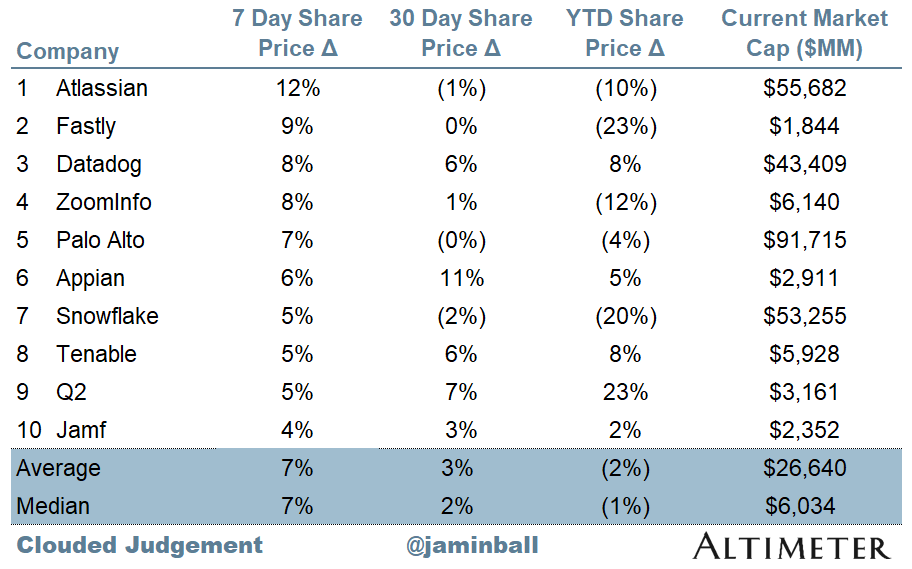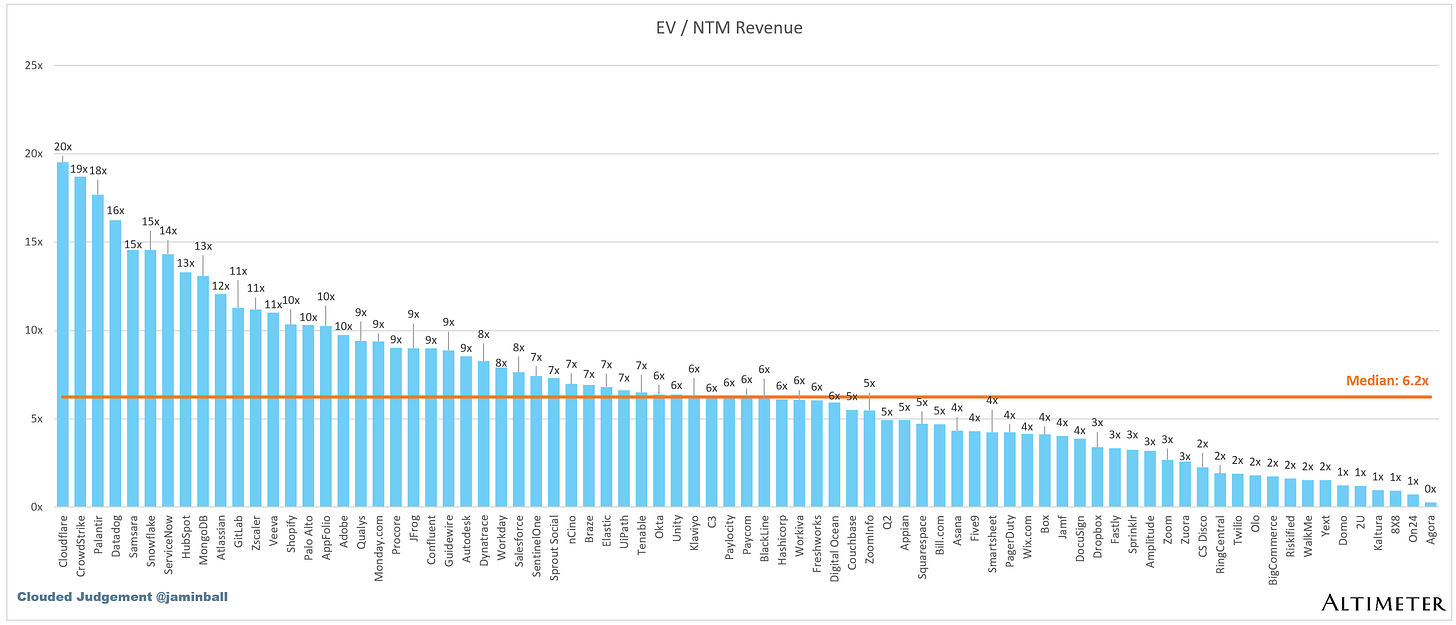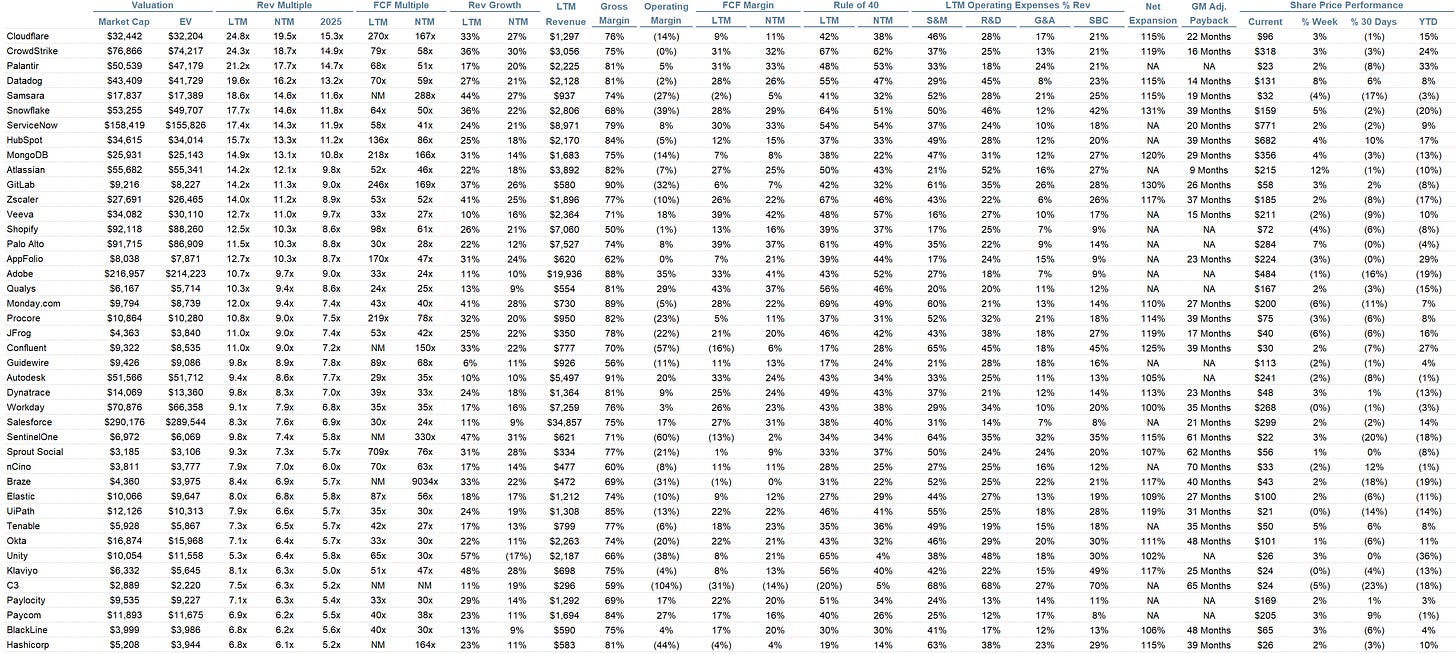Clouded Judgement 4.12.24 - March CPI Update
Every week I’ll provide updates on the latest trends in cloud software companies. Follow along to stay up to date!
March Inflation (CPI) Update
CPI:
March CPI YoY was +3.5% vs expectations of +3.4% (and +3.2% in February)
March CPI MoM +0.4% vs expectations of +0.3% (and +0.4% in February)
March Core CPI (ex Food/Energy) YoY +3.8% vs expectations of +3.7% (and +3.8% in February)
March Core CPI (ex Food/Energy) MoM +0.4% vs expectations of +0.3% (and +0.4% in February)
We’ve now had a few months in a row of inflation picking up. This has resulted in the consensus shifting on the timing and quantity of rate cuts the market expects for this year. The graph below shows the market’s expectations for the Fed Funds rate at three points in time. The beginning of the year (yellow), right before the March inflation figures (light green), and right after the march inflation figures (dark green).
As you can see - the consensus expectations have shifted dramatically! Just over three months ago the market was expecting the fed funds rate to be ~3.5% in Jan ‘25. The current Fed Funds rate is 5.33%, so a drop to 3.5% implied ~8 Fed cuts (each cut typically 0.25%). Today, the market is expecting only 2 cuts from now until Jan ‘25! So we’ve gone from the market expecting 8 cuts, to the market expecting only 2. And the March CPI figures alone resulted in a significant change in rate expectations.
As expected with these results, the 10Y has steadily risen this year. The 10Y has gone from 3.9% to 4.6%! We most likely won’t see rate cuts until we see inflation starting to fall again.
What’s maybe most interesting about the rise in the 10Y is the relatively little impact it’s had on software valuations. The average YTD performance of my index of ~80 software companies is only down 5%. A 5% average drop vs a ~18% rise in the 10Y doesn’t feel entirely right (would have expected more of a drop). On top of that, the median NTM revenue multiple has only fell 1% from the start of the year to today. The median softwrae multiple has stayed range bound from ~6.0x - 6.4x throughout the year. Q1 was also not a catalyst for forward estimates going up. This tells me the market is expecting one of two things - a true re-acceleration in top line that will show up in the short term, or inflation to reverse course and start falling again in the short term.
Top 10 EV / NTM Revenue Multiples
Top 10 Weekly Share Price Movement
Update on Multiples
SaaS businesses are generally valued on a multiple of their revenue - in most cases the projected revenue for the next 12 months. Revenue multiples are a shorthand valuation framework. Given most software companies are not profitable, or not generating meaningful FCF, it’s the only metric to compare the entire industry against. Even a DCF is riddled with long term assumptions. The promise of SaaS is that growth in the early years leads to profits in the mature years. Multiples shown below are calculated by taking the Enterprise Value (market cap + debt - cash) / NTM revenue.
Overall Stats:
Overall Median: 6.2x
Top 5 Median: 17.7x
10Y: 4.6%
Bucketed by Growth. In the buckets below I consider high growth >27% projected NTM growth (I had to update this, as there’s only 1 company projected to grow >30% after this quarter’s earnings), mid growth 15%-27% and low growth <15%
High Growth Median: 9.4x
Mid Growth Median: 9.0x
Low Growth Median: 4.3x
EV / NTM Rev / NTM Growth
The below chart shows the EV / NTM revenue multiple divided by NTM consensus growth expectations. So a company trading at 20x NTM revenue that is projected to grow 100% would be trading at 0.2x. The goal of this graph is to show how relatively cheap / expensive each stock is relative to their growth expectations
EV / NTM FCF
The line chart shows the median of all companies with a FCF multiple >0x and <100x. I created this subset to show companies where FCF is a relevant valuation metric.
Companies with negative NTM FCF are not listed on the chart
Scatter Plot of EV / NTM Rev Multiple vs NTM Rev Growth
How correlated is growth to valuation multiple?
Operating Metrics
Median NTM growth rate: 13%
Median LTM growth rate: 17%
Median Gross Margin: 75%
Median Operating Margin (11%)
Median FCF Margin: 11%
Median Net Retention: 110%
Median CAC Payback: 39 months
Median S&M % Revenue: 41%
Median R&D % Revenue: 25%
Median G&A % Revenue: 16%
Comps Output
Rule of 40 shows rev growth + FCF margin (both LTM and NTM for growth + margins). FCF calculated as Cash Flow from Operations - Capital Expenditures
GM Adjusted Payback is calculated as: (Previous Q S&M) / (Net New ARR in Q x Gross Margin) x 12 . It shows the number of months it takes for a SaaS business to payback their fully burdened CAC on a gross profit basis. Most public companies don’t report net new ARR, so I’m taking an implied ARR metric (quarterly subscription revenue x 4). Net new ARR is simply the ARR of the current quarter, minus the ARR of the previous quarter. Companies that do not disclose subscription rev have been left out of the analysis and are listed as NA.
Sources used in this post include Bloomberg, Pitchbook and company filings
The information presented in this newsletter is the opinion of the author and does not necessarily reflect the view of any other person or entity, including Altimeter Capital Management, LP ("Altimeter"). The information provided is believed to be from reliable sources but no liability is accepted for any inaccuracies. This is for information purposes and should not be construed as an investment recommendation. Past performance is no guarantee of future performance. Altimeter is an investment adviser registered with the U.S. Securities and Exchange Commission. Registration does not imply a certain level of skill or training.
This post and the information presented are intended for informational purposes only. The views expressed herein are the author’s alone and do not constitute an offer to sell, or a recommendation to purchase, or a solicitation of an offer to buy, any security, nor a recommendation for any investment product or service. While certain information contained herein has been obtained from sources believed to be reliable, neither the author nor any of his employers or their affiliates have independently verified this information, and its accuracy and completeness cannot be guaranteed. Accordingly, no representation or warranty, express or implied, is made as to, and no reliance should be placed on, the fairness, accuracy, timeliness or completeness of this information. The author and all employers and their affiliated persons assume no liability for this information and no obligation to update the information or analysis contained herein in the future.

















